Holger Caesar
BikeScenes: Online LiDAR Semantic Segmentation for Bicycles
Oct 29, 2025Abstract:The vulnerability of cyclists, exacerbated by the rising popularity of faster e-bikes, motivates adapting automotive perception technologies for bicycle safety. We use our multi-sensor 'SenseBike' research platform to develop and evaluate a 3D LiDAR segmentation approach tailored to bicycles. To bridge the automotive-to-bicycle domain gap, we introduce the novel BikeScenes-lidarseg Dataset, comprising 3021 consecutive LiDAR scans around the university campus of the TU Delft, semantically annotated for 29 dynamic and static classes. By evaluating model performance, we demonstrate that fine-tuning on our BikeScenes dataset achieves a mean Intersection-over-Union (mIoU) of 63.6%, significantly outperforming the 13.8% obtained with SemanticKITTI pre-training alone. This result underscores the necessity and effectiveness of domain-specific training. We highlight key challenges specific to bicycle-mounted, hardware-constrained perception systems and contribute the BikeScenes dataset as a resource for advancing research in cyclist-centric LiDAR segmentation.
ECCV 2024 W-CODA: 1st Workshop on Multimodal Perception and Comprehension of Corner Cases in Autonomous Driving
Jul 02, 2025
Abstract:In this paper, we present details of the 1st W-CODA workshop, held in conjunction with the ECCV 2024. W-CODA aims to explore next-generation solutions for autonomous driving corner cases, empowered by state-of-the-art multimodal perception and comprehension techniques. 5 Speakers from both academia and industry are invited to share their latest progress and opinions. We collect research papers and hold a dual-track challenge, including both corner case scene understanding and generation. As the pioneering effort, we will continuously bridge the gap between frontier autonomous driving techniques and fully intelligent, reliable self-driving agents robust towards corner cases.
A Vehicle System for Navigating Among Vulnerable Road Users Including Remote Operation
May 08, 2025Abstract:We present a vehicle system capable of navigating safely and efficiently around Vulnerable Road Users (VRUs), such as pedestrians and cyclists. The system comprises key modules for environment perception, localization and mapping, motion planning, and control, integrated into a prototype vehicle. A key innovation is a motion planner based on Topology-driven Model Predictive Control (T-MPC). The guidance layer generates multiple trajectories in parallel, each representing a distinct strategy for obstacle avoidance or non-passing. The underlying trajectory optimization constrains the joint probability of collision with VRUs under generic uncertainties. To address extraordinary situations ("edge cases") that go beyond the autonomous capabilities - such as construction zones or encounters with emergency responders - the system includes an option for remote human operation, supported by visual and haptic guidance. In simulation, our motion planner outperforms three baseline approaches in terms of safety and efficiency. We also demonstrate the full system in prototype vehicle tests on a closed track, both in autonomous and remotely operated modes.
VoteFlow: Enforcing Local Rigidity in Self-Supervised Scene Flow
Mar 28, 2025Abstract:Scene flow estimation aims to recover per-point motion from two adjacent LiDAR scans. However, in real-world applications such as autonomous driving, points rarely move independently of others, especially for nearby points belonging to the same object, which often share the same motion. Incorporating this locally rigid motion constraint has been a key challenge in self-supervised scene flow estimation, which is often addressed by post-processing or appending extra regularization. While these approaches are able to improve the rigidity of predicted flows, they lack an architectural inductive bias for local rigidity within the model structure, leading to suboptimal learning efficiency and inferior performance. In contrast, we enforce local rigidity with a lightweight add-on module in neural network design, enabling end-to-end learning. We design a discretized voting space that accommodates all possible translations and then identify the one shared by nearby points by differentiable voting. Additionally, to ensure computational efficiency, we operate on pillars rather than points and learn representative features for voting per pillar. We plug the Voting Module into popular model designs and evaluate its benefit on Argoverse 2 and Waymo datasets. We outperform baseline works with only marginal compute overhead. Code is available at https://github.com/tudelft-iv/VoteFlow.
Towards Vision Zero: The Accid3nD Dataset
Mar 15, 2025Abstract:Even though a significant amount of work has been done to increase the safety of transportation networks, accidents still occur regularly. They must be understood as unavoidable and sporadic outcomes of traffic networks. No public dataset contains 3D annotations of real-world accidents recorded from roadside sensors. We present the Accid3nD dataset, a collection of real-world highway accidents in different weather and lighting conditions. It contains vehicle crashes at high-speed driving with 2,634,233 labeled 2D bounding boxes, instance masks, and 3D bounding boxes with track IDs. In total, the dataset contains 111,945 labeled frames recorded from four roadside cameras and LiDARs at 25 Hz. The dataset contains six object classes and is provided in the OpenLABEL format. We propose an accident detection model that combines a rule-based approach with a learning-based one. Experiments and ablation studies on our dataset show the robustness of our proposed method. The dataset, model, and code are available on our website: https://accident-dataset.github.io.
CoDa-4DGS: Dynamic Gaussian Splatting with Context and Deformation Awareness for Autonomous Driving
Mar 09, 2025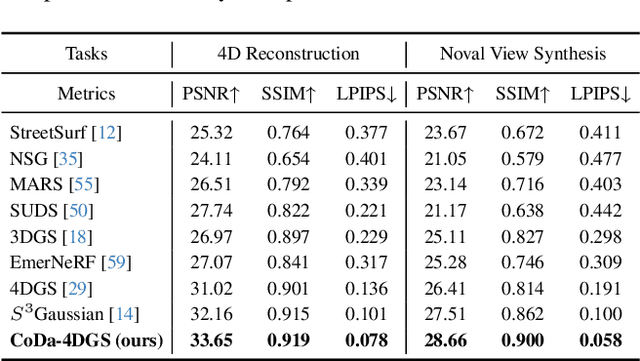

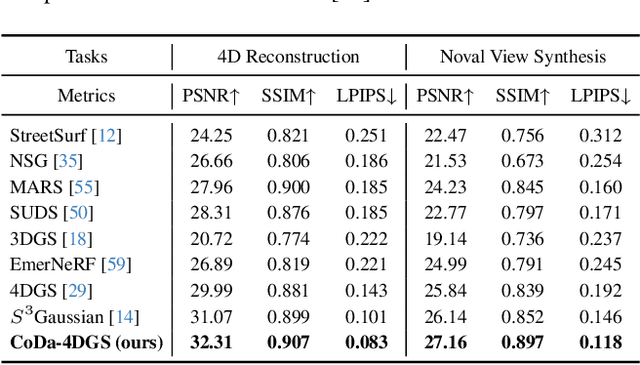
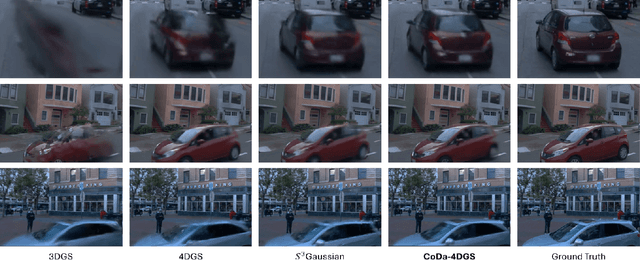
Abstract:Dynamic scene rendering opens new avenues in autonomous driving by enabling closed-loop simulations with photorealistic data, which is crucial for validating end-to-end algorithms. However, the complex and highly dynamic nature of traffic environments presents significant challenges in accurately rendering these scenes. In this paper, we introduce a novel 4D Gaussian Splatting (4DGS) approach, which incorporates context and temporal deformation awareness to improve dynamic scene rendering. Specifically, we employ a 2D semantic segmentation foundation model to self-supervise the 4D semantic features of Gaussians, ensuring meaningful contextual embedding. Simultaneously, we track the temporal deformation of each Gaussian across adjacent frames. By aggregating and encoding both semantic and temporal deformation features, each Gaussian is equipped with cues for potential deformation compensation within 3D space, facilitating a more precise representation of dynamic scenes. Experimental results show that our method improves 4DGS's ability to capture fine details in dynamic scene rendering for autonomous driving and outperforms other self-supervised methods in 4D reconstruction and novel view synthesis. Furthermore, CoDa-4DGS deforms semantic features with each Gaussian, enabling broader applications.
LeAP: Consistent multi-domain 3D labeling using Foundation Models
Feb 06, 2025Abstract:Availability of datasets is a strong driver for research on 3D semantic understanding, and whilst obtaining unlabeled 3D point cloud data is straightforward, manually annotating this data with semantic labels is time-consuming and costly. Recently, Vision Foundation Models (VFMs) enable open-set semantic segmentation on camera images, potentially aiding automatic labeling. However,VFMs for 3D data have been limited to adaptations of 2D models, which can introduce inconsistencies to 3D labels. This work introduces Label Any Pointcloud (LeAP), leveraging 2D VFMs to automatically label 3D data with any set of classes in any kind of application whilst ensuring label consistency. Using a Bayesian update, point labels are combined into voxels to improve spatio-temporal consistency. A novel 3D Consistency Network (3D-CN) exploits 3D information to further improve label quality. Through various experiments, we show that our method can generate high-quality 3D semantic labels across diverse fields without any manual labeling. Further, models adapted to new domains using our labels show up to a 34.2 mIoU increase in semantic segmentation tasks.
OSSA: Unsupervised One-Shot Style Adaptation
Oct 01, 2024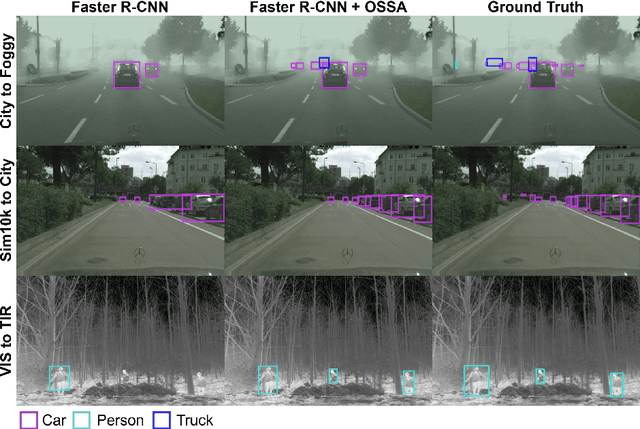
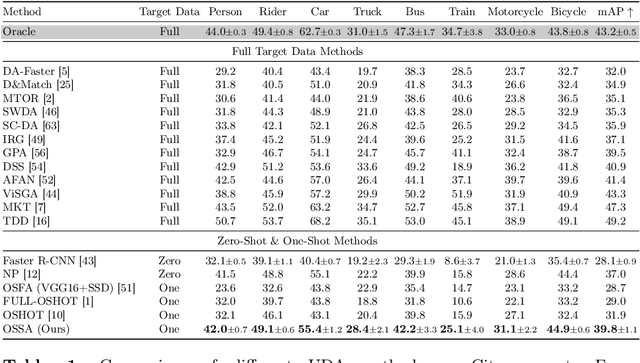
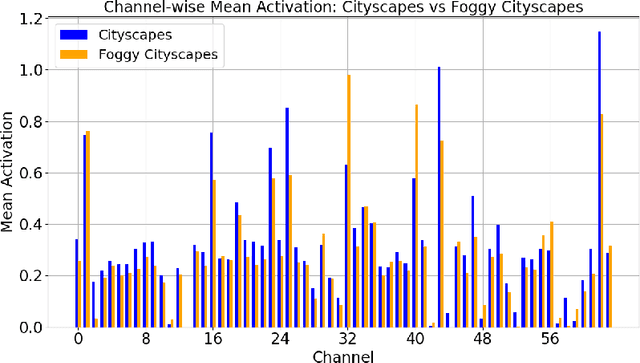
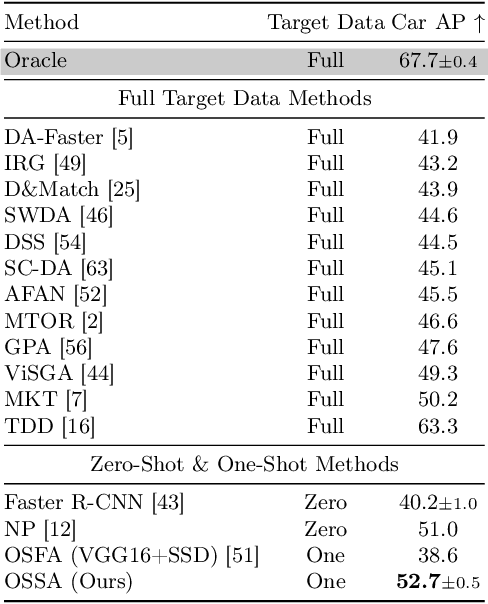
Abstract:Despite their success in various vision tasks, deep neural network architectures often underperform in out-of-distribution scenarios due to the difference between training and target domain style. To address this limitation, we introduce One-Shot Style Adaptation (OSSA), a novel unsupervised domain adaptation method for object detection that utilizes a single, unlabeled target image to approximate the target domain style. Specifically, OSSA generates diverse target styles by perturbing the style statistics derived from a single target image and then applies these styles to a labeled source dataset at the feature level using Adaptive Instance Normalization (AdaIN). Extensive experiments show that OSSA establishes a new state-of-the-art among one-shot domain adaptation methods by a significant margin, and in some cases, even outperforms strong baselines that use thousands of unlabeled target images. By applying OSSA in various scenarios, including weather, simulated-to-real (sim2real), and visual-to-thermal adaptations, our study explores the overarching significance of the style gap in these contexts. OSSA's simplicity and efficiency allow easy integration into existing frameworks, providing a potentially viable solution for practical applications with limited data availability. Code is available at https://github.com/RobinGerster7/OSSA
OpenPSG: Open-set Panoptic Scene Graph Generation via Large Multimodal Models
Jul 15, 2024



Abstract:Panoptic Scene Graph Generation (PSG) aims to segment objects and recognize their relations, enabling the structured understanding of an image. Previous methods focus on predicting predefined object and relation categories, hence limiting their applications in the open world scenarios. With the rapid development of large multimodal models (LMMs), significant progress has been made in open-set object detection and segmentation, yet open-set relation prediction in PSG remains unexplored. In this paper, we focus on the task of open-set relation prediction integrated with a pretrained open-set panoptic segmentation model to achieve true open-set panoptic scene graph generation (OpenPSG). Our OpenPSG leverages LMMs to achieve open-set relation prediction in an autoregressive manner. We introduce a relation query transformer to efficiently extract visual features of object pairs and estimate the existence of relations between them. The latter can enhance the prediction efficiency by filtering irrelevant pairs. Finally, we design the generation and judgement instructions to perform open-set relation prediction in PSG autoregressively. To our knowledge, we are the first to propose the open-set PSG task. Extensive experiments demonstrate that our method achieves state-of-the-art performance in open-set relation prediction and panoptic scene graph generation. Code is available at \url{https://github.com/franciszzj/OpenPSG}.
Redefining Automotive Radar Imaging: A Domain-Informed 1D Deep Learning Approach for High-Resolution and Efficient Performance
Jun 11, 2024Abstract:Millimeter-wave (mmWave) radars are indispensable for perception tasks of autonomous vehicles, thanks to their resilience in challenging weather conditions. Yet, their deployment is often limited by insufficient spatial resolution for precise semantic scene interpretation. Classical super-resolution techniques adapted from optical imaging inadequately address the distinct characteristics of radar signal data. In response, our study redefines radar imaging super-resolution as a one-dimensional (1D) signal super-resolution spectra estimation problem by harnessing the radar signal processing domain knowledge, introducing innovative data normalization and a domain-informed signal-to-noise ratio (SNR)-guided loss function. Our tailored deep learning network for automotive radar imaging exhibits remarkable scalability, parameter efficiency and fast inference speed, alongside enhanced performance in terms of radar imaging quality and resolution. Extensive testing confirms that our SR-SPECNet sets a new benchmark in producing high-resolution radar range-azimuth images, outperforming existing methods across varied antenna configurations and dataset sizes. Source code and new radar dataset will be made publicly available online.
 Add to Chrome
Add to Chrome Add to Firefox
Add to Firefox Add to Edge
Add to Edge